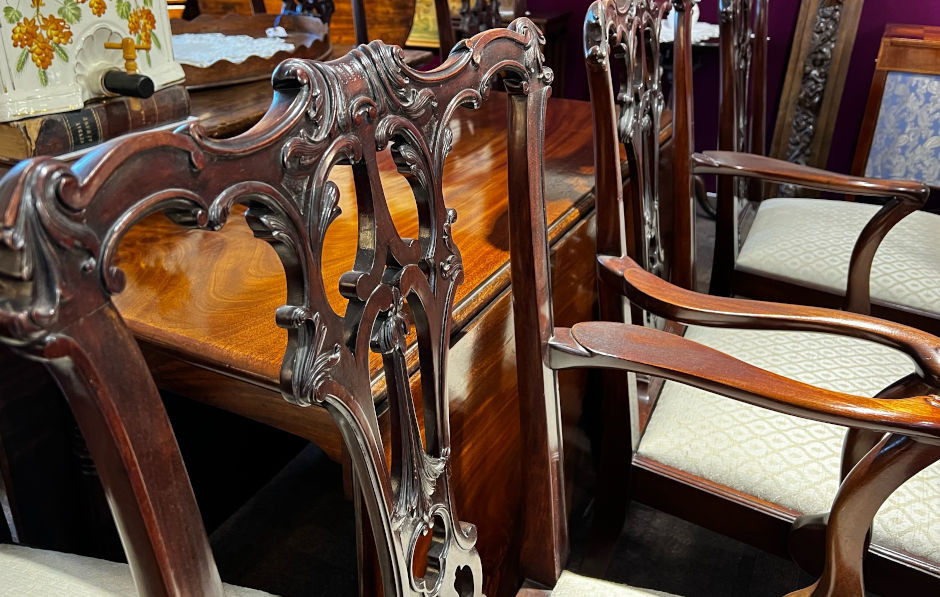
When shopping for antique furniture, it is vital to prove the authenticity of the pieces you are considering buying. Here are our tips on how to tell if furniture is antique or reproduction.
For individual collectors, or those buyers acting on the instructions of a client, who are looking for antique period furniture, it is important to know if pieces are genuine antiques or forgeries, and to understand the difference between reproduction pieces and fakes.
What is antique furniture?
Experts and authorities in the field agree that the term ‘antique’ refers to something made at least 100 years ago, and where a piece cannot be dated definitively to at least a hundred years, it should not be referred to as antique.
What is reproduction furniture?
As the name implies, reproduction furniture is made to look like, or reproduce the look of, its antique counterpart and is an imitation or copy of the original style or item. However, beware of confusing ‘reproduction’ with ‘forged’. There are reproduction pieces which are now themselves antiques and therefore hold their own place amongst antiques but, they must be sold as such. Sellers who are not open about a piece being a reproduction and who sell it as an antique, are in breach of the Trades Description Act.
How to tell if furniture is antique or reproduction
There are key areas to be aware of when distinguishing a genuine antique item from a reproduction, and any buyer should learn to recognise the following:
How antique furniture ages
Where a maker has attempted to artificially age a piece of reproduction furniture, the wear will be consistent. An antique, by comparison, will exhibit degrees of wear that has occurred over time. Check drawer runners – there should be signs of age from drawers being opened multiple times, and examine the underside of feet which should also exhibit wear. Genuine antique furniture develops a patina over time through exposure to polish, dust and simple age. This patina is often reproduced artificially by staining.
Materials used in antique furniture
Early antique furniture was made using several types of wood because often the primary wood variety was too expensive to use for all elements of the item. Less visible parts of a piece of antique furniture (backs and drawer inners for example) will be made from cheaper wood. A reproduction will likely be made entirely from one type of wood, and those less visible areas may well be made from manufactured wood such as plywood.
The workmanship in antique furniture
Quality reproduction furniture displays fine workmanship but will often show telltale signs of modern techniques. These can be seen in uniform, machine-made dimensions that an older, hand-made piece will not have. Examine the hardware closely too. The nails and screws, and also handles, on an antique will be old, and difficult to mimic accurately. While many reproduction pieces will use the same techniques to construct a piece of furniture, for example the use of dovetail joints, they will be machine-produced and much more uniform in appearance.
What is restoration?
Restoration is the name given to the process of restoring an antique item to its original appearance and condition. There are occasions when carrying out an honest restoration on a piece of antique furniture is perfectly acceptable, for instance where the restoration undertaken will prevent the item from deteriorating further. Examples of honest restoration include replacing veneers or adding new feet to a piece, or reupholstering a chair using contemporary fire-retardant materials in order for it to comply with regulations. In these cases, the item is not in its original condition but is still considered to be antique. Where restoration has been carried out, it must be declared and not undertaken with the intent to deceive.
Where to buy genuine antique furniture
There is undoubtedly a healthy market for quality reproduction furniture, but buyers looking for genuine antique pieces know that to guarantee authenticity, it is best to buy from dealers and centres that have trade association accreditation. At Hemswell, many of our dealers are BADA accredited (British Antique Dealers’ Association) and members of LAPADA (the Association of Art and Antiques Dealers).
We welcome visitors to our four buildings and two coffee shops, and invite buyers to spend a day with us in the historic setting of the former RAF Hemswell, home to the Lancaster Bomber during WWII. For those commercial clients unable to visit us in person, and who may be sourcing several pieces of period furniture from overseas, we are able to arrange a virtual tour of pieces of interest, where you will be accompanied by our Managing Director. Please contact us for further details.